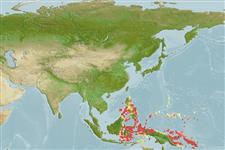>
Eupercaria/misc (Various families in series Eupercaria) >
Labridae (Wrasses) > Cheilininae
Etymology: Pseudocheilinops: Greek, pseudes = false + Greek, cheilos = lip + Greek, ops = appearance (Ref. 45335).
More on author: Schultz.
Environment: milieu / climate zone / depth range / distribution range
Ecología
marino asociado a arrecife; rango de profundidad 5 - 15 m (Ref. 90102). Tropical; 19°N - 8°S
Western Central Pacific: southern Philippines and Celebes (Indonesia) to Palau.
Tamaño / Peso / Age
Maturity: Lm ? range ? - ? cm
Max length : 6.5 cm TL macho / no sexado; (Ref. 48636)
Short description
Claves de identificación | Morfología | Morfometría
Espinas dorsales (total) : 9; Radios blandos dorsales (total) : 11; Espinas anales: 3; Radios blandos anales: 9.
Mainly found in still coastal waters, where brittle corals grow high. Occurs in small groups that feed actively among the lower and dead parts of the corals with coralline algae. Easily overlooked because of its small size. Length to 6.5 cm, but usually much smaller (Ref. 48636). Always hides or stays close to its shelter (Ref. 90102). A secretive species. Feeds on amphipods and other small invertebrates. Rarely found in the aquarium trade.
Life cycle and mating behavior
Madurez | Reproducción | Puesta | Huevos | Fecundidad | Larva
Oviparous, distinct pairing during breeding (Ref. 205).
Westneat, M.W., 2001. Labridae. Wrasses, hogfishes, razorfishes, corises, tuskfishes. p. 3381-3467. In K.E. Carpenter and V. Niem (eds.) FAO species identification guide for fishery purposes. The living marine resources of the Western Central Pacific. Vol. 6. Bony fishes part 4 (Labridae to Latimeriidae), estuarine crocodiles. FAO, Rome. (Ref. 9823)
IUCN Red List Status (Ref. 130435: Version 2024-1)
Threat to humans
Harmless
Human uses
Pesquerías: sin interés
Herramientas
Special reports
Download XML
Fuentes de Internet
Estimates based on models
Preferred temperature (Ref.
123201): 28.5 - 29.4, mean 28.9 °C (based on 681 cells).
Phylogenetic diversity index (Ref.
82804): PD
50 = 1.0000 [Uniqueness, from 0.5 = low to 2.0 = high].
Bayesian length-weight: a=0.01585 (0.00700 - 0.03587), b=2.95 (2.76 - 3.14), in cm total length, based on LWR estimates for this (Sub)family-body shape (Ref.
93245).
Nivel trófico (Ref.
69278): 3.4 ±0.45 se; based on food items.
Resiliencia (Ref.
120179): Alto, población duplicada en un tiempo mínimo inferior a 15 meses (Preliminary K or Fecundity.).
Fishing Vulnerability (Ref.
59153): Low vulnerability (10 of 100).
Nutrients (Ref.
124155): Calcium = 172 [97, 337] mg/100g; Iron = 1.04 [0.57, 2.01] mg/100g; Protein = 18.3 [15.4, 20.6] %; Omega3 = 0.166 [0.093, 0.292] g/100g; Selenium = 20.6 [10.4, 40.8] μg/100g; VitaminA = 165 [48, 681] μg/100g; Zinc = 2.5 [1.6, 4.0] mg/100g (wet weight);
